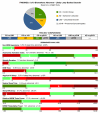Concordance and test-retest consistency of sleep biomarker-based neurodegenerative disorder profiling
- PMID: 39732824
- PMCID: PMC11682374
- DOI: 10.1038/s41598-024-82528-y
Concordance and test-retest consistency of sleep biomarker-based neurodegenerative disorder profiling
Abstract
Biomarkers that aid in early detection of neurodegeneration are needed to enable early symptomatic treatment and enable identification of people who may benefit from neuroprotective interventions. Increasing evidence suggests that sleep biomarkers may be useful, given the bi-directional relationship between sleep and neurodegeneration and the prominence of sleep disturbances and altered sleep architectural characteristics in several neurodegenerative disorders. This study aimed to demonstrate that sleep can accurately characterize specific neurodegenerative disorders (NDD). A four-class machine-learning algorithm was trained using age and nine sleep biomarkers from patients with clinically-diagnosed manifest and prodromal NDDs, including Alzheimer's disease dementia (AD = 27), Lewy body dementia (LBD = 18), and isolated REM sleep behavior disorder (iRBD = 15), as well as a control group (CG = 58). The algorithm was validated in a total of 381 recordings, which included the training data set plus an additional AD = 10, iRBD = 18, Parkinson disease without dementia (PD = 29), mild cognitive impairment (MCI = 78) and CG = 128. Test-retest consistency was then assessed in LBD = 10, AD = 9, and CG = 46. The agreement between the NDD profiles and their respective clinical diagnoses exceeded 75% for the AD, LBD, and CG, and improved when NDD participants classified Likely Normal with NDD indications consistent with their clinical diagnosis were considered. Profiles for iRBD, PD and MCI participants were consistent with the heterogeneity of disease severities, with the majority of overt disagreements explained by normal sleep characterization in 27% of iRBD, 21% of PD, and 26% of MCI participants. For test-retest assignments, the same or similar NDD profiles were obtained for 88% of LBD, 86% in AD, and 98% of CG participants. The potential utility for NDD subtyping based on sleep biomarkers demonstrates promise and requires further prospective development and validation in larger NDD cohorts.
Keywords: Alzheimer’s disease; Neurodegenerative disease; Non-REM hypertonia; Parkinsonian spectrum disorders; REM sleep behavior disorder; Sleep biomarkers.
© 2024. The Author(s).
Conflict of interest statement
Declarations. Competing interests: Mr. Levendowski and Ms. Berka would benefit financially if the Sleep Profiler intellectual property was sold to a third party. The remaining authors declare that the research was conducted in the absence of any commercial or financial relationships that could be construed as a potential conflict of interest. Dr. Lee-Iannotti serves as a paid advisor to and speaker for Jazz Pharmaceuticals. Dr. Boeve receives honoraria for SAB activities for the Tau Consortium; research support from Alector, Biogen, Transposon and GE Healthcare. Dr. Lewis is a consultant for Pharmaxis Ltd.
Figures


Similar articles
-
Proof-of-concept for characterization of neurodegenerative disorders utilizing two non-REM sleep biomarkers.Front Neurol. 2023 Oct 20;14:1272369. doi: 10.3389/fneur.2023.1272369. eCollection 2023. Front Neurol. 2023. PMID: 37928153 Free PMC article.
-
Autonomic dysregulation during sleep in Parkinsonian spectrum disorders - A proof of concept.Parkinsonism Relat Disord. 2023 Dec;117:105905. doi: 10.1016/j.parkreldis.2023.105905. Epub 2023 Nov 3. Parkinsonism Relat Disord. 2023. PMID: 37939637 Free PMC article.
-
Association of REM sleep behavior disorder and neurodegenerative disease may reflect an underlying synucleinopathy.Mov Disord. 2001 Jul;16(4):622-30. doi: 10.1002/mds.1120. Mov Disord. 2001. PMID: 11481685
-
Rapid eye movement sleep behavior disorder: devising controlled active treatment studies for symptomatic and neuroprotective therapy--a consensus statement from the International Rapid Eye Movement Sleep Behavior Disorder Study Group.Sleep Med. 2013 Aug;14(8):795-806. doi: 10.1016/j.sleep.2013.02.016. Epub 2013 Jul 22. Sleep Med. 2013. PMID: 23886593 Free PMC article.
-
Prodromal dementia with Lewy bodies.Psychol Med. 2015 Jan;45(2):259-68. doi: 10.1017/S0033291714000816. Epub 2014 Apr 3. Psychol Med. 2015. PMID: 25066469 Review.
Cited by
-
Novel technologies for REM sleep behavior disorder detection for home screening in Parkinson's disease and related alpha-synucleinopathies.NPJ Parkinsons Dis. 2025 Jul 3;11(1):196. doi: 10.1038/s41531-025-01032-w. NPJ Parkinsons Dis. 2025. PMID: 40610478 Free PMC article.
-
Development of Neurodegenerative Disease Diagnosis and Monitoring from Traditional to Digital Biomarkers.Biosensors (Basel). 2025 Feb 11;15(2):102. doi: 10.3390/bios15020102. Biosensors (Basel). 2025. PMID: 39997004 Free PMC article. Review.
References
-
- Ferini-Strambi, L. & Salsone, M. Glymphatic neurodegeneration: Is sleep the missing key? Clin. Transl Neurosci.8, ctn8020023. 10.3390/ctn8020023 (2024).

